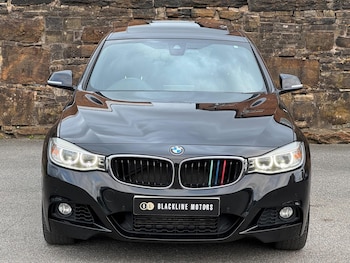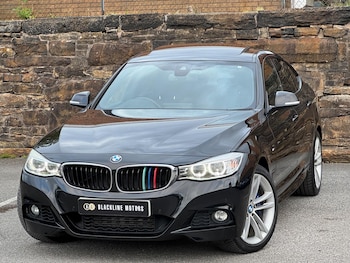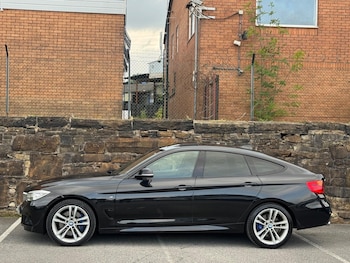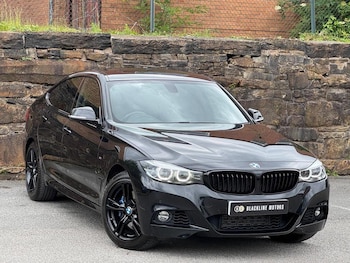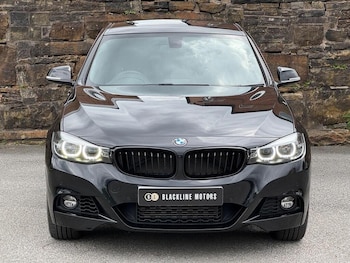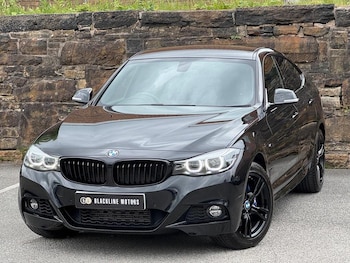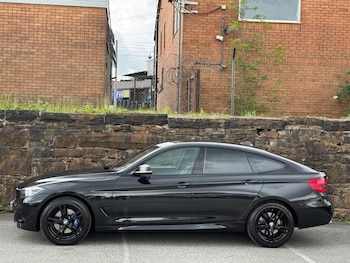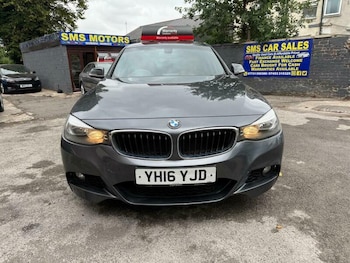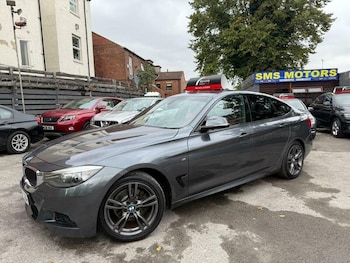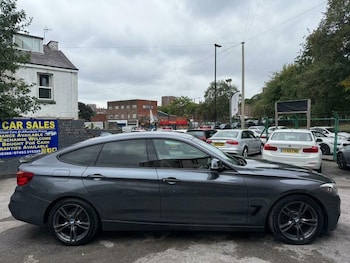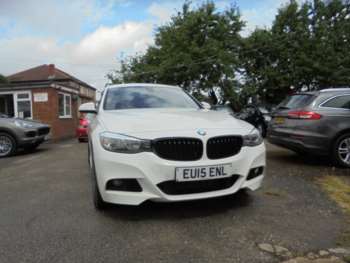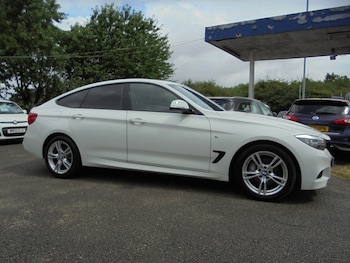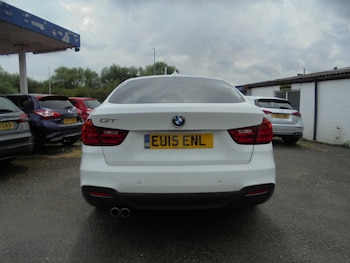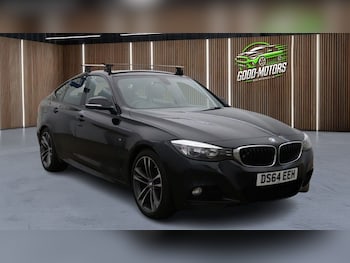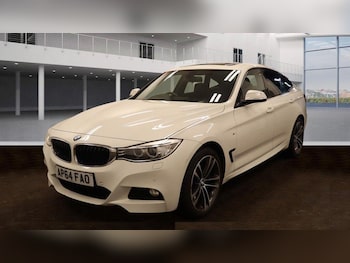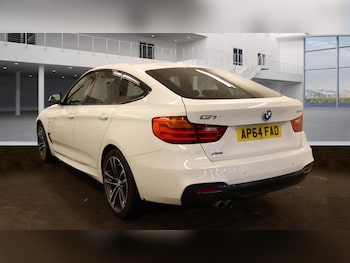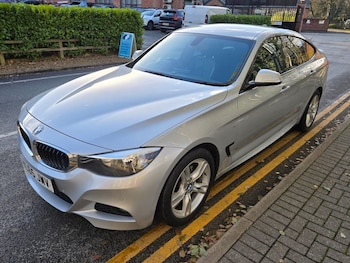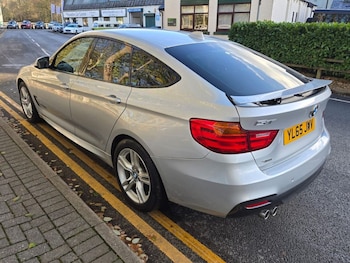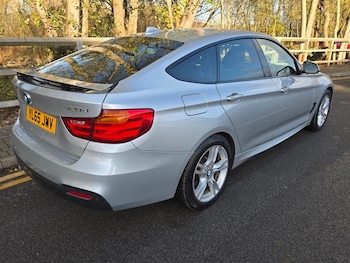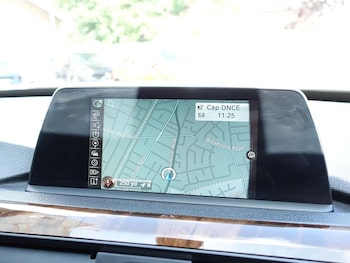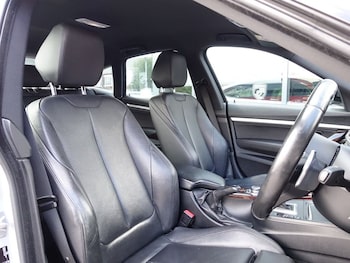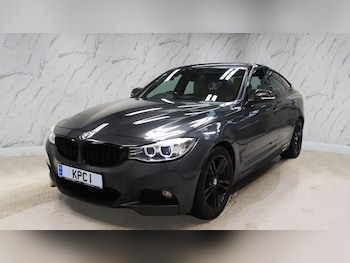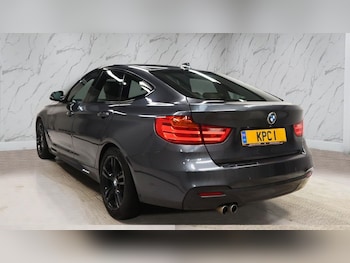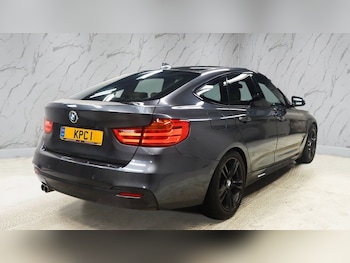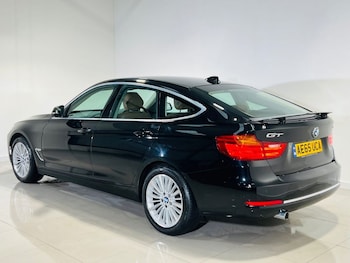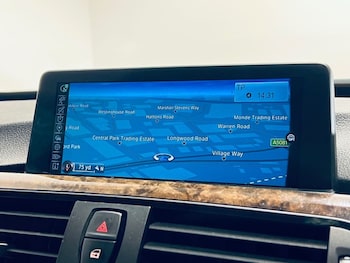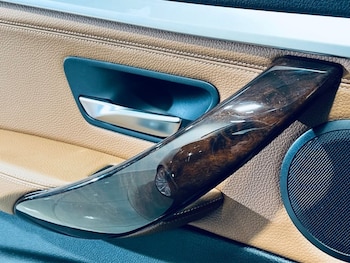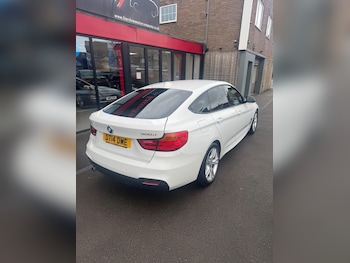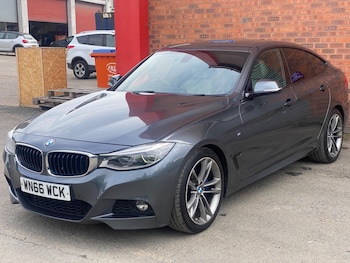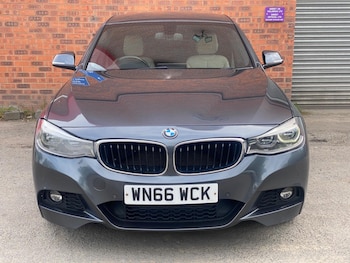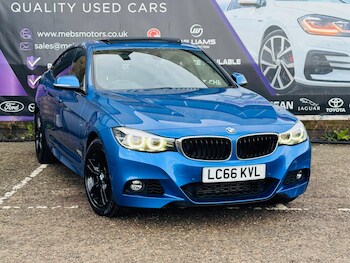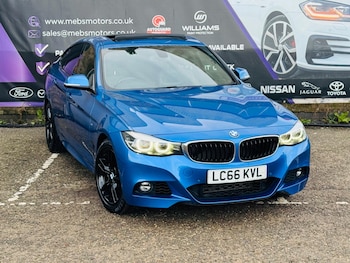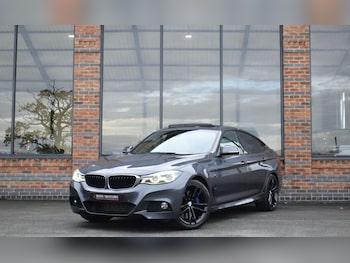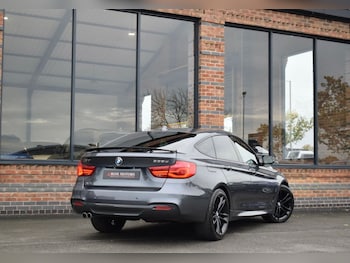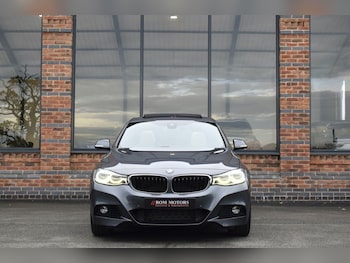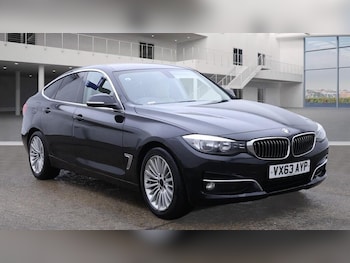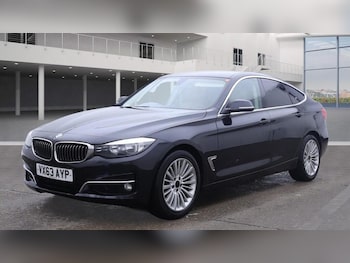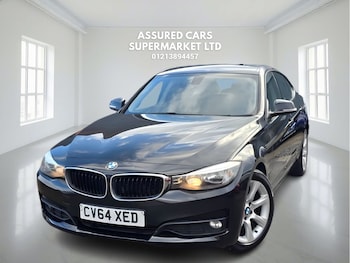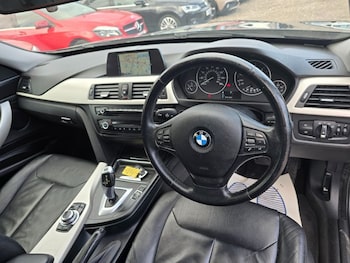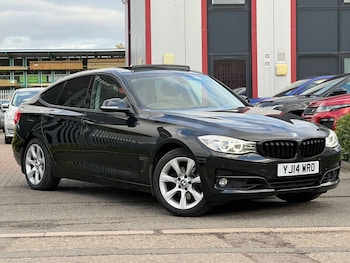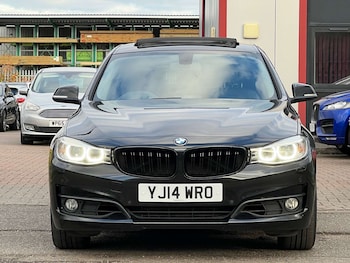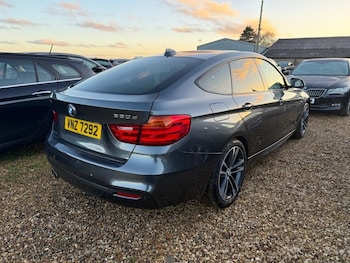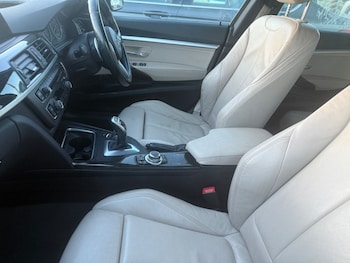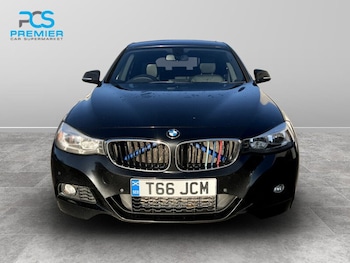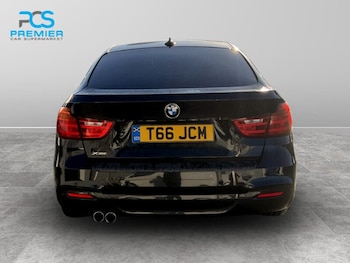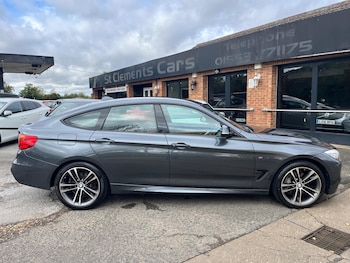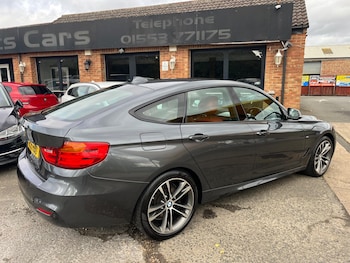Used BMW 3 Series Gran Turismo cars for sale
The BMW 3 Series Gran Turismo occupies a unique spot in the executive car market. It's the model that BMW developed for drivers who loved the 3 Series but needed more practicality without stepping up to a full SUV. With its clever liftback design, raised ride height, and generous boot space, the 3 GT bridges the gap between traditional saloon elegance and family-friendly versatility.
If you're considering a used BMW 3 Series Gran Turismo, you're looking at a car that offers genuine everyday usability wrapped in premium build quality. Whether you're after the efficient 320d or the sportier 340i, there's a 3 GT variant that can match your lifestyle. Let's explore what makes this model worth considering and what you should know before making a purchase.
Why buy a used BMW 3 Series Gran Turismo?
The Gran Turismo appeals to buyers who want something different from the usual executive car formula. It's ideal if you regularly carry passengers in the back or need to load up for weekends away, yet still want the driving dynamics BMW is known for.
One of the standout features is the boot space. With 520 litres of capacity (and up to 1,600 litres with the rear seats folded), it offers significantly more room than a standard 3 Series saloon. The powered tailgate and wide opening make loading bulkier items straightforward, which is perfect for families or anyone who enjoys outdoor pursuits.
The raised seating position gives you a better view of the road ahead without feeling like you're perched high up in an SUV. Rear passengers benefit from generous headroom and legroom thanks to the higher roofline, making longer journeys more comfortable for everyone on board.
From a value perspective, buying a used BMW 3 Series GT makes excellent financial sense. The 3 GT didn't sell in huge numbers compared to the regular 3 Series, which means depreciation has already taken its toll on early models. You can pick up a well-specified example for considerably less than you'd pay for an equivalent saloon or Touring.
BMW 3 Series Gran Turismo overview
BMW introduced the 3 Series Gran Turismo in 2013 as part of the F30 generation. It was designed to offer more practicality than the standard 3 Series whilst maintaining the brand's focus on driver engagement. Production continued until 2019, when BMW decided not to replace it, instead encouraging buyers towards the 3 Series Touring or X3.
The 3 GT measures 4,824mm in length, making it 200mm longer than the saloon. That extra length translates directly into more interior space and a larger boot. The distinctive silhouette divides opinion—some appreciate its purposeful stance, whilst others feel it lacks the visual cohesion of the regular 3 Series. Whichever camp you fall into, there's no denying the practical benefits it brings.
Inside, you'll find the familiar BMW cabin layout with quality materials and intuitive controls. The dashboard features the iDrive infotainment system, which improved significantly throughout the model's lifespan. Later models gained larger touchscreens, improved navigation, and better smartphone integration.
Standard equipment varies depending on the trim level and year, but most 3 GTs come with climate control, parking sensors, and alloy wheels. Higher-spec models add luxuries like leather upholstery, heated seats, and adaptive suspension.
BMW 3 GT generations and trims
The 3 Series Gran Turismo was produced as a single generation (F34) from 2013 to 2019. Within that timeframe, BMW made gradual improvements to equipment levels, technology, and efficiency.
F34 (2013–2019)
The F34 arrived with a range of petrol and diesel engines. The most popular choice in the UK was the 320d, which offered an excellent balance of performance and economy. The 2.0-litre diesel produces 190bhp and delivers strong mid-range acceleration, making it ideal for motorway driving.
Petrol options included the 320i and later the 330i, both using turbocharged 2.0-litre units. These provide smoother, quieter operation than the diesels but with higher running costs. At the top of the range sat the 340i, packing a 3.0-litre straight-six engine with 326bhp for genuinely rapid performance.
In 2016, BMW introduced a facelift that refreshed the exterior styling with revised headlights and bumpers. The update also brought improvements to the infotainment system and additional driver assistance features on higher trims.
Trim levels
BMW offered several trim levels across the 3 GT's production run:
SE: The entry-level trim came with 17-inch alloys, dual-zone climate control, DAB radio, and parking sensors. It provides everything you need for daily use without unnecessary extras.
Luxury: Added leather upholstery, ambient lighting, and chrome exterior detailing. This trim focused on comfort and refinement.
Modern: Featured a sportier look with different alloy designs, sports seats, and unique interior trim finishes.
M Sport: The most popular choice among buyers, M Sport added aggressive body styling, lowered suspension, larger alloys, and sports seats. It's the trim to choose if driving enjoyment is a priority.
GT Sport: Introduced later in the model's life, GT Sport sat between Luxury and M Sport, offering a blend of comfort features and sportier styling elements.
What is the difference between BMW 3 Series and 3 Series Gran Turismo?
The main differences lie in practicality and design. The Gran Turismo is longer, taller, and has a liftback boot rather than a traditional saloon bootlid. This gives you 520 litres of boot space compared to 480 litres in the saloon, plus the advantage of a much wider opening for loading larger items.
The 3 GT also sits 81mm higher than the standard 3 Series, which provides better visibility and easier access for passengers getting in and out. Rear seat passengers enjoy significantly more headroom thanks to the raised roofline.
From a driving perspective, the 3 GT feels slightly less agile than the saloon due to its increased weight and higher centre of gravity. It's still engaging to drive by executive car standards, but if ultimate handling precision is your priority, the regular BMW 3 Series edges ahead.
The trade-off is worth it for many buyers who value the extra versatility. The 3 GT makes more sense if you regularly carry passengers or need the flexibility of a larger boot without committing to an SUV.
What to look for when buying a used BMW 3 Series GT
Before committing to a BMW 3 Series GT for sale, conduct thorough checks to ensure you're buying a well-maintained example:
Service history: A complete service record is essential. BMW recommends servicing every 12 months or 10,000 miles, whichever comes first. Look for evidence of regular oil changes and any warranty work carried out.
Runflat tyres: Many 3 GTs came with runflat tyres as standard, which can be expensive to replace. Check the tread depth and look for uneven wear that might indicate suspension issues.
Electronics: Test all the infotainment features, parking sensors, and camera systems. Electronic glitches can be costly to repair, so make sure everything functions correctly during your inspection.
Diesel particulate filter (DPF): If you're considering a diesel model, ensure it's been used regularly for longer journeys. DPFs can clog if the car's only done short trips, leading to expensive repairs.
Suspension: Listen for any knocking noises from the suspension, particularly over bumps. The adaptive suspension fitted to some models can develop faults that are expensive to fix.
Interior condition: Check the leather seats for wear, especially on the driver's side. Examine the boot area for signs of heavy use or water ingress around the tailgate seals.
Is the BMW 3 Series GT a reliable used car?
BMW's reliability record with the F34 3 Series Gran Turismo is generally positive. Most mechanical components prove durable when properly maintained, and the engines—particularly the diesel units—have a strong reputation for longevity.
That said, as with any premium German car, keeping up with scheduled maintenance is crucial. Skipping services or ignoring warning lights can lead to bigger problems down the line. The timing chain on some petrol engines should be checked at higher mileages, as replacement can be costly if it fails.
Electronics occasionally cause frustrations, with some owners reporting issues with the iDrive system or parking sensors. These problems are usually fixable but can involve dealer visits.
Overall, a well-maintained used BMW 3 Series Gran Turismo should provide reliable service for years to come, provided you stay on top of servicing and address any issues promptly.
What are common issues with the BMW 3 GT?
Whilst the 3 GT is generally dependable, a few recurring issues have been reported:
Turbocharger problems: Some diesel models have experienced turbocharger failures, particularly on higher-mileage examples. Listen for unusual whistling sounds or check for excessive smoke from the exhaust.
Oil leaks: Rocker cover gaskets can leak oil over time. Check for oil residue around the engine and look for low oil level warnings on the dashboard.
Cooling system: Water pump failures have been reported on some models. Keep an eye on the temperature gauge and investigate any overheating issues immediately.
Electrical gremlins: Occasional glitches with parking sensors, reversing cameras, or infotainment screens have been noted. These are usually software-related and can often be resolved with updates.
Rear suspension: The air suspension on some models can develop leaks, causing the rear of the car to sag. Repairs can be expensive, so test the car over various road surfaces.
What engine options are available in the BMW 3 Series GT?
BMW offered a comprehensive range of engines throughout the 3 GT's production:
Diesel engines:
- 318d: 2.0-litre four-cylinder producing 143bhp
- 320d: 2.0-litre four-cylinder producing 190bhp (most popular choice)
- 330d: 3.0-litre six-cylinder producing 258bhp
- 335d: 3.0-litre six-cylinder producing 313bhp (rare but rapid)
Petrol engines:
- 320i: 2.0-litre four-cylinder producing 184bhp
- 328i: 2.0-litre four-cylinder producing 245bhp
- 330i: 2.0-litre four-cylinder producing 252bhp
- 340i: 3.0-litre six-cylinder producing 326bhp
The 320d remains the sensible choice for most buyers, offering excellent fuel economy (up to 62mpg) combined with strong performance. If you cover lower annual mileages, the 320i petrol provides a quieter, smoother alternative with respectable running costs.
Does the 3 GT come with xDrive all-wheel drive?
Yes, BMW offered xDrive all-wheel drive as an option on most 3 GT models. The system intelligently distributes power between the front and rear wheels to maximise traction in slippery conditions.
xDrive adds a small weight penalty and marginally increases fuel consumption, but it's worth considering if you live in a rural area or regularly drive in adverse weather. The system operates seamlessly and provides reassuring grip when roads become greasy or snow-covered.
Most UK examples were sold with rear-wheel drive, which keeps the car lighter and more engaging to drive in normal conditions. xDrive models command slightly higher prices on the used market due to their rarity and added versatility.
Is the BMW 320d GT a good car for long-distance driving?
Absolutely. The 320d GT excels as a long-distance cruiser. The diesel engine delivers strong mid-range torque, making motorway overtaking effortless. Fuel economy hovers around 55-60mpg on longer runs, which translates to impressive range between fill-ups.
The raised seating position and excellent visibility reduce fatigue on extended journeys. Rear passengers have ample space to stretch out, and the smooth ride quality (especially on models with adaptive suspension) keeps everyone comfortable.
Road and wind noise are well suppressed at motorway speeds, and the standard cruise control (with optional adaptive cruise on higher trims) takes the strain out of motorway miles. Add in a quality sound system and climate control, and you have a relaxing environment for eating up distances.
How much boot space does the 3 GT offer?
The BMW 3 Series Gran Turismo provides 520 litres of boot space with all seats in place. Fold the 40/20/40 split rear seats down, and that capacity expands to 1,600 litres.
The liftback design gives you a wide, square opening that makes loading bulky items straightforward. The boot floor is relatively flat when the seats are folded, and there's minimal loading lip to lift items over.
Practical touches include storage nets, tie-down points, and an underfloor compartment for valuables. The powered tailgate (standard on most models) operates with a wave of your foot under the rear bumper if you've got your hands full.
This level of practicality puts the 3 GT on par with many SUVs whilst maintaining a lower, sleeker profile that's easier to park and more efficient to run.
How much does a used BMW 3 Series Gran Turismo cost in the UK?
Prices for a used BMW 3 Series Gran Turismo vary depending on age, mileage, specification, and condition. Early 2013-2014 models in SE trim with higher mileages can be found from around £8,000-£10,000. These represent excellent value if you're after a spacious, premium executive car on a budget.
Mid-range examples from 2015-2017 with average mileages typically cost between £12,000-£18,000. This bracket offers the sweet spot of reasonable depreciation with plenty of life left in the car.
Later facelift models from 2017-2019 in M Sport trim with lower mileages command £20,000-£28,000. These cars benefit from the updated technology and styling whilst still offering significant savings compared to new car prices.
Rare high-performance variants like the 340i or 335d carry a premium, especially with xDrive and full service history. Expect to pay towards the top end of the range for these models.
When browsing BMW GT 3 Series listings, factor in running costs including warranty coverage, insurance, and potential maintenance expenses to ensure the car fits comfortably within your budget.
What trim level is best for the BMW 3 GT?
Your ideal trim depends on priorities and budget. SE provides all the essentials at the lowest price point, making it suitable if you're focused purely on practicality and value.
Luxury adds comfort features that enhance the ownership experience without dramatically increasing costs. It's worth considering if you spend considerable time in the car and appreciate premium materials.
M Sport remains the most desirable trim for most buyers. The sportier styling, improved handling from the lowered suspension, and better standard equipment make it feel more special. Residual values also hold up better on M Sport models.
GT Sport offers a middle ground if you want some sporty styling elements but prefer a more comfortable ride than M Sport provides. It's less common on the used market but worth considering if you find one.
Ultimately, focus on finding a well-maintained example with full service history rather than fixating on trim level alone. A carefully kept SE model will provide better long-term satisfaction than a neglected M Sport.
Frequently Asked Questions
What is the difference between BMW 3 Series and 3 Series Gran Turismo?
The Gran Turismo (GT) is a more spacious, hatchback-style version of the standard 3 Series, offering extra boot space and a higher driving position.
Is the BMW 3 Series GT a reliable used car?
Generally, yes—the 3 Series GT has a reputation for reliability when well maintained, but always check service history before buying.
What are common issues with the BMW 3 GT?
Common issues can include electrical gremlins, worn suspension components, and occasional turbo or EGR valve troubles, especially on higher-mileage diesels.
What engine options are available in the BMW 3 Series GT?
You'll find both petrol and diesel options, including the popular 320d diesel and lively 330i petrol. Engines vary by year and market.
How much boot space does the 3 GT offer?
The 3 GT boasts a generous boot, with up to 520 litres of space—great for luggage or even a big weekly shop.
What should I check before buying a used BMW 3 GT?
Look for a full service history, check for unusual noises or warning lights, and ensure electronics are working. A thorough test drive is always a good idea.
Does the 3 GT come with xDrive all-wheel drive?
Yes, some models are available with BMW’s xDrive all-wheel drive system, offering extra confidence on slippery roads.
Is the BMW 320d GT a good car for long-distance driving?
Absolutely! The 320d GT is known for comfortable cruising, strong fuel economy, and plenty of space, making it a popular choice for frequent travellers.
How much does a used BMW 3 Series Gran Turismo cost in the UK?
Prices vary based on age, mileage, and trim, but you can generally expect to pay between £10,000 and £25,000 for a quality used example.
This depends on your priorities—M Sport is sporty and well-equipped, while SE or Luxury trims offer comfort and value. It’s about finding the right balance for your needs.

